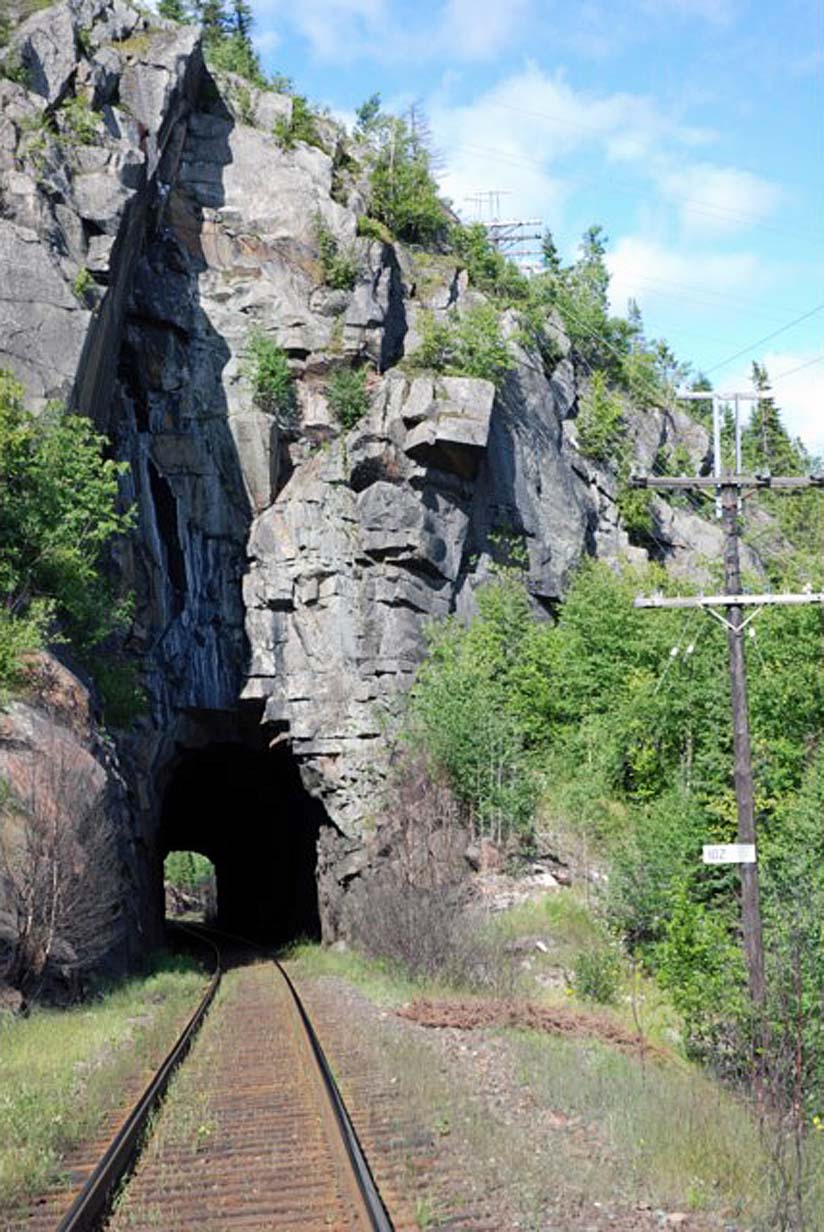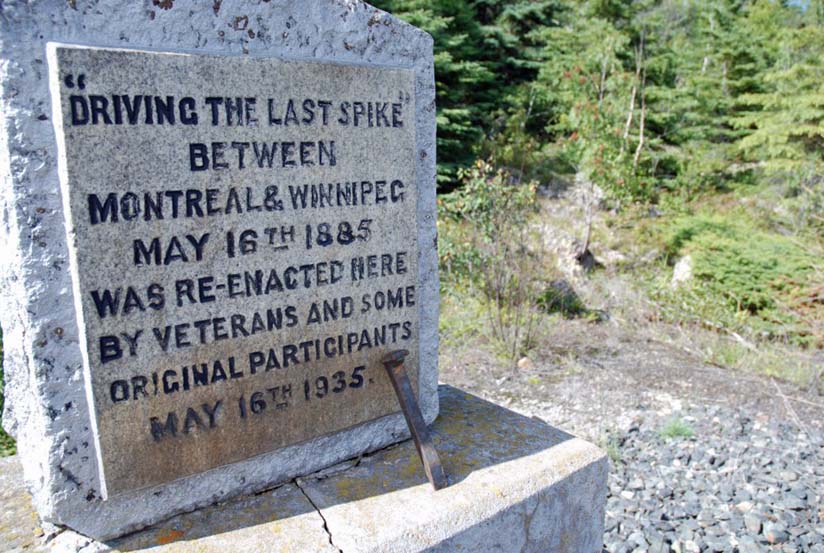
Jackfish Ontario - We don't have the opportunity to go through tunnels much.
A tunnel is an underground passageway that takes you somewhere, tunnels are important then.
There are few railway tunnels in eastern Canada.
We most often think of the colossal tunnelling effort through the western mountains by the Canadian Pacific Railway (CP) syndicate of the late
1800's.
We know the well-known black and white photograph featured in the introduction of Pierre Berton's "The Last Spike" with all those men with the long
beards and moustaches and tall hats.
It is the ceremonial driving of CP's last spike into the rail bed in the Craigellachie Mountains within British Columbia's interior.
 There are no Craigellachie Mountains. Craigellachie, the site of the driving of Canadian Pacific Railway's Last Spike, is located in the Monashee
Mountains.
There are no Craigellachie Mountains. Craigellachie, the site of the driving of Canadian Pacific Railway's Last Spike, is located in the Monashee
Mountains.
Some of the major figures of Canadian history are there, Donald Smith, William Van Horne, and Sir Sandford Fleming.
Canadian legends that became college and street names.
Who knew there are tunnels in eastern Canada on Lake Superior?
But there is another, less well-known tunnel, the Jackfish Bay tunnel, east of Terrace Bay.
Also at that location, you have the opportunity to visit the commemorative cairn of the last spike.

Two last spikes?
 There's more than two and it's still somewhat of a mystery
There's more than two and it's still somewhat of a mystery .
.
It requires a little nation-building heritage appreciation.
On 15 Feb 1881, the Canadian Pacific Railway Act received Royal Assent.
Before this time there was no way to sell a Canadian immigrant a ticket to sit down and ride the rails arriving in British Columbia.
The best bet was to use a combination of rail, water transport, and horse-drawn carts.
The journey would eventually become cold and damp.
Maybe steamboat, canoes, and trails got you to the prairies, then horseback across the mid-west.
Once arriving in the mountains the immigrant became stuck.
Rivers, via canoe, was the best way to complete the trek to the west coast.
But there was a change in the making, by Sir John A. Macdonald, our first Prime Minister and the CP railway syndicate.
 Initially the name "Canadian Pacific" was a generic term referring to any railroad that would reach Pacific tidewater from the east. The CP
Canadian Pacific Railway Company was incorporated in 1881 utilizing the generic name.
Initially the name "Canadian Pacific" was a generic term referring to any railroad that would reach Pacific tidewater from the east. The CP
Canadian Pacific Railway Company was incorporated in 1881 utilizing the generic name.
The principal terms were provided by a payment to the syndicate through a subsidy of $25,000,000 and 25,000,000 acres of land, plus sections of railway lines
already under construction.
Today, railway property, often located within municipal waterfronts is both valuable and contentious.
Within 15 years of the passage of the bill, a pioneer was able to travel from Montreal to Vancouver in less than six days sitting in a warm, dry,
seat.
Today you can travel from Vancouver to Halifax by passenger train in segments.
Rail enthusiasts can purchase a 22 day train vacation trip package starting at $11,300.
 That figure should be verified, but I'm positive there are very few enthusiasts I know who would pay that amount.
That figure should be verified, but I'm positive there are very few enthusiasts I know who would pay that amount.
Building the CP was more about achieving nationhood for Canada in the 1880s, coast to coast, than it was about building a railway as an elegant and showy
operation.
A lot of money and a lot of rock were eaten to build an all-Canadian route, rather than building through easier terrain in the United States as original CP
railway syndicate members would have preferred.
 James J. Hill, a Canadian known as America's Empire Builder, quit the CP company organization as a result of the decision to build an all-Canadian
route north of Lake Superior. His Great Northern Railroad eventually became a competitor of CP in certain arenas.
James J. Hill, a Canadian known as America's Empire Builder, quit the CP company organization as a result of the decision to build an all-Canadian
route north of Lake Superior. His Great Northern Railroad eventually became a competitor of CP in certain arenas.
The Lake Superior section became costly, problematic, and construction was generally slow to complete.
The cost of dynamiting and moving rock was appalling.
There are three tunnels you may visit in this area, and they reflect the most challenging barrier of the day.
At the Jackfish tunnel, you can appreciate how much of the line was chiselled into the rocky shore, using the technology of the 1880's.
Lake Superior is always close at hand.
Imagine what the terrain here was like before the railway came, and how much rock had to be moved by horse and manual labour in the course of drilling and
blasting the tunnel.
Then the rock and fill had to be moved in to provide a roadbed suitable for laying track.
Consider the work involved in building a railway line in the day.
Between Marathon and Terrace Bay you see how most of the hills are granite with just enough soil to support trees.
When you consider that railways usually rise a maximum of 2.2 units vertically for every 100 units travelled horizontally the answer for early civil engineers
was the proposed railway line had to hug the shoreline.
The grade over distance had to be gradual.
Two Last Spikes
Why did the engineers of the day build tunnels?
Tunnel Bay is about 1 kilometre across at its outlet.
Who knows what kind of bridge you'd need to construct to withstand Lake Superior's "sea" storms and damaging ice.
How deep would you have to go to place your bridge footings in the bay?
CP had hundreds of more kilometres to think about building in the 1880s, so Tunnel Bay never got a bridge, it got a tunnel.
Instead of an impossible one kilometre bridge, the train travels 5 kilometres (three miles), close to lake level, around Jackfish Bay.
As you watch a train wind its way snake-like around the bay, the scenery dwarfs even the very long trains of today.
The entire view probably won't fit into your camera's viewfinder.
As you walk this section the archives tell us this was one of the most expensive and difficult sections of railway construction.
You can Google the historic Jackfish location at
N48.815117 W86.962317 .
.
In the summer of 1884, there were 15,000 men and 4,000 horses working on the north shore of Lake Superior.
Records indicate the workers consumed twelve tons of food per day, and four tons of tobacco each month.
It is amazing to consider not one locomotive train, steam shovel, or power drill was utilized on this rugged landscape.
It was indeed laborious.
The area near Jackfish, including three railway tunnels, cost $1,200,000 in capital dollars of the day.
A short walk westwards, to Noslo a little less than one kilometre, will lead you to one of those historic events we take for granted.
Noslo spelled backwards, is the surname Olson, a railway management person.
Many of the sidings and whistle stops are names spelled backwards.
A nod to the railway construction crews of the day.
It is a milestone, an accomplishment.
The last spike for the section from Montreal to Winnipeg was driven at mile 102.7 in May of 1885.
You will want to read the inscription on the plaque.
It is the last spike in completing this eastern section of railway construction.
The inscription reads, Driving the Last Spike Between Montreal & Winnipeg, May 16th, 1885.
Present was Colonel Oswald of the Montreal Light Infantry, along with his troops on the first train eastwards.
They were returning home from the Riel Rebellion in Saskatchewan.
It was one of the major factors in completing this difficult stretch of railway construction.
These tunnels are more than just symbolic, they link our historic events.
While in the neighbourhood, you can also visit an abandoned tunnel on Highway 11 near Nipigon.
You will be standing on the abandoned Canadian National Kinghorn sub line from Longlac to Nipigon and westward to Thunder Bay.
By mid-July 2009 the western portion of the Kinghorn Subdivision was completely dismantled and left for the history books.
For the Jackfish tunnel, and two smaller CP tunnels just to the east of Neys Provincial Park, and the Nipigon tunnel see the map.
Remember to stay off the tracks.
Author unknown.
(because there was no image with original article)
(usually because it's been seen before)
provisions in Section 29 of the Canadian
Copyright Modernization Act.
